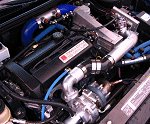

|
Street Class Unlimited Class
DOHC SOHC Ion Updated 1/05 For the most recent list of the fastest five cars click here. |
Cams 101by: Nefarious***Disclaimer: high performance cams and cam tuning is an adventure of epic proportions. Before you go out and spend $500 or so on cams and sprockets, you need to first decide how "in depth" you are willing to go. Cam tuning is a great way to fine tune your Satty's hidden power. However, it's also a great way to cause mad problems, spend some change, and want to make you kick the neighbor's dog. I STRONGLY RECOMEND THAT A WELL QUALIFIED MECHANIC, OR A REAL CONFIDENT SATURN FREAK, PERFORM THE NECESSARY INSTALL AND TUNING PROCEDURES. As I'm sure you're aware, quite a bit goes into this project, and it won't take much for all hell to break loose*** These are serious tuning tools and should only be used by serious enthusiasts, once you introduce shaved heads, better exhausts, higher duration cams, and better air intakes, you tweak the optimum cam timing set forth by the manufacturer. From the factory, cams usually operate at a conservative setting to meet drivability and smog standards, with that said even stock motors can be tweaked to better performance by changing the stock overlap, overlap is the precise point when the intake/exhaust valves open at the same time, this is very important because performance tuning will maximize the air/fuel mixture in and out of the combustion chamber, but keep in mind that tweaking the cam timing tweaks the overall performance as well as the overall drivability of the Saturn's motor, that's why I say these should only be used for serious tuning, my setup for instance is NOT street friendly by any means, adjusting the power curve should be done with consideration of the car's purpose. Don't think of cam tuning as a big power builder, the fact is I've only seen gains in the upper RPM range of 5HP. The purposes for me are to adjust the power curve for better acceleration. My setup is for drag racing only so take that into consideration before you go out and mimic others. One more thing before we start, remember that adjusting the sprockets are not to be confused with altering the lift and duration of the valves, that is the cam shafts job, that's where the cam profile comes into play, when I say profile I mean the precise lift and duration for the intake and exhaust valves (through the cam lobes), these are detailed by the cam grinder or manufacturer. To broaden everyone's cam vocabulary, I've added these terms and definitions to assist the article. TDC: top dead center These terms are used to present the piston's position within the combustion chamber BDC: bottom dead center It is important to have a basic understanding of the pistons and their relationship with the valve train. The pistons regulate the valve's positions through the crank onto the timing chain, connected to the cam sprockets witch turn the cams. Valves open and close at their precise times to accommodate the piston's 4 part cycle throughout the combustion chamber. The cycle goes like this: 1. The power stroke: is when the piston has reached TDC, both the exhaust and intake valves are closed, as the spark plug fires, the ignited fuel and air mixture forces the piston downward, before the piston reaches BDC, the exhaust valve begins to open...carrying onto the next part 2. The exhaust stroke: when the piston reaches BDC and begins its travel upward, the exhaust valve goes fully open and begins to close as the piston reaches TDC pushing out the unburned exhaust gases, at the same time, the intake valves begin to open drawing in fresh air while the exhaust valves are still partially open, thus moving onto the 3. Intake stroke: the piston is at TDC, and both exhaust and intake valves are part way open, as the piston makes its way downward, the exhaust valve goes fully shut, and the intake valve goes wide open then starts to close (during this stroke is where adjusting the "overlap" comes into play, more on this later) the final stroke is the 4. Compression stroke: this is simply the piston reaching BDC and starting its way upward, the exhaust valve is still shut, and the intake valve becomes completely shut, then the cycle starts over and returns to the Power stroke Centerline: for a simple explanation, The number of degrees the crankshaft must turn from TDC until the cam reaches the peak of the lobe will be the centerline. Duration: is how long the valve is actually held open through the camshaft in relation to the crankshaft's rotation. The length of time the valve is held open is measured in degrees of crankshaft rotation. in other words, if a given camshaft has a spec of lets say 220 degrees duration, all this means is that the cam will hold the valve open for 220 degrees of 1 crankshaft rotation. Valve overlap: occurs during the Intake stroke, and is when both intake and exhaust valves are open. Proper overlap is critical for maximum performance, because overlap will determine the velocity of the spent exhaust gases leaving the combustion chamber in conjunction with the intake air being pulled into the combustion chamber. In a nut shell, the ideal overlap position will create a vacuum and allow the exhaust gases to be pushed out of the combustion chamber, while fresh air is pulled in. Sounds simple, but tuning the cams to such a balance is not easy and is very time consuming. But with some patience and alittle luck the benefits will out weigh the costs. Lift: not to be confused with duration is how wide the valve will be held open, this is important because not opened enough will restrict the air's entrance and exit from the cylinder, but at the same time, opening to much will not allow any more air to flow then at a conservative setting. Now we move on to asking the question "How do I know what needs to be adjusted?" Again, I must stress that one needs to decided their tuning goals before they begin. With that said, we need to point out the two types of cam adjustment: Advance and Retard, and how they will affect the overall performance. For TSN members new and old, we'll keep it simple and address the 2 main scenarios; Tuning a twin cam's exhaust and intake (or just one, but why?) and single cam tuning. Advance and Retard tuning will obviously differ with the addition of 1 more, or 1 less cam. For the best results, the idea for both is to maximize the valve overlap. Again, advancing or retarding will move the power band up or down for low end or high end gains. Normally, the driver won't feel the difference unless there are adjustments of 4 degrees +/-. For some, the advantages of tuning will be to accurately feel what the car is doing, not gaining 5 or 6 HP. Also, each individual application will carry different variables (different engine modifications) that will call for different timing configurations. SO NO COPYING!!! (Thank god we have electronic ignition systems or this article would lose people quick!) Tuning cams is also the best way in my opinion to compensate for all those bolt on parts out there, and even turbo setups where the engine is breathing a lot more air than the norm. For N/A engines, a more aggressive cam is recommended, as in turbo applications, examples have shown that stock cams will do. Furthermore, recognizing cam profiles and factory timing settings will greatly assist in the tuning process by giving you a good place to start, and the best place to go back to. To properly adjust the cams, you need to recognize where the valve sits in reference to the pistons. This is where the cam/piston relationship comes into play. If you try to tune in mid stroke for instance, you wont get the results you're expecting. The best results from my experiences are when I turned the crank and begin when the valves opens at TDC Saturn SpecificAdvancing: means to rotate the cam ahead to open up the intake or exhaust valve sooner. Saturn timing chains run clockwise so turning the cam clockwise will advance. Keep in mind that SOHC will open the intake sooner and open up the exhaust valve later (because they ride on the same cam) DOHC engines can advance one side or the other, or vise versa. That is why I cant stress enough dyno tuning is essential. Retarding: means to rotate the cam behind to close the intake or exhaust valve later. Once again the Saturn crank turns clockwise, so to retard you must rotate the cam counter clockwise. On the Saturn's SOHC motor, the cam's lobes will be in charge of both the intake and exhaust valves. So the only two options are to advance or retard, but keep in mind: although cam tuning on a SOHC will not do jack for overlap, it WILL SHIFT YOUR CURVE TO THE UPPER RPM RANGE. This is ideal for drag racers who need all the power at the top end. Retarding will do the opposite. Fine tuning can max the engines power for example at 4 to 5K RPM's by retarding the cams position. This is beneficial to autocross racers whom need all their power at low end, in and out of the turns. The twin cam peeps out there have a slight advantage because they can maximize overlap throughout the entire RPM range AND shift the power curve by properly dialing in the intake and exhaust cams simultaneously. Twin cam tuners, typically spend more time on the dyno to get to their desired outcome. (I know I've spent enough for all of us) but the results are to die for. LOL In conclusion, there are no "standard settings" out there. Each of us have different mods that require different adjustments. If anything I hope those unsure have a better understanding. I've gone for a simple explanation here, so those whom have outside questions or wish to pick my brain for the hardcore details can PM me. With all this said, read a book, or ask around after all this doesn't doesn't seem to be enough to help. I don't know, maybe I just got lucky, after all, all I've done is taken the above info. And put it to practical trials and errors, I'm no mechanical engineer, but i managed to tune my sh!t very well. GOOD LUCK! Here is some additional information for those people that want
to further research cams. Link |
|



